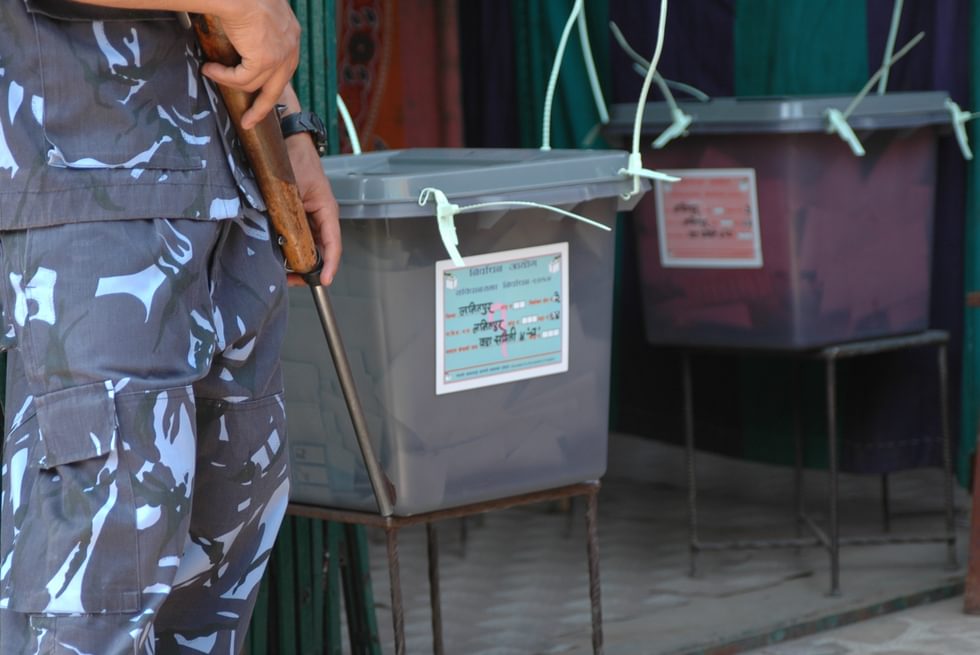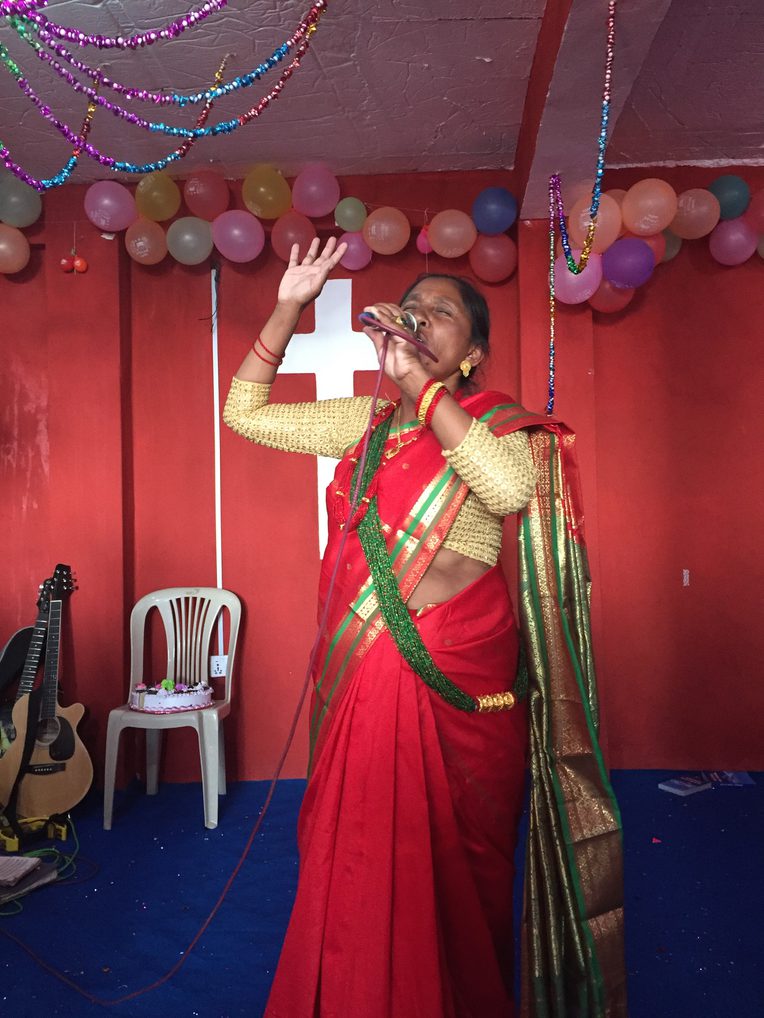Cruel Optimism, Christianity, and the Postconflict Optic
From the Series: The Politics of “Postconflict”: On the Ground in South Asia
From the Series: The Politics of “Postconflict”: On the Ground in South Asia

It is Saturday morning in Gorkha Bazaar, an administrative town in the rural mid-hills of Nepal. In a small cinder-block building on the edge of town, seventy-some people of all ages, genders, castes, and ethnicities are raising their voices and waving their arms, pouring out their hearts to Parmeswar, as they call the Christian God. The atmosphere is charged with emotion as the crowd prays, praising Parmeswar’s power, thanking him for his love, and beseeching him for help—for a job, for a spouse’s illness to be cured, for a son to return safely from labor abroad, for relief from sorrow or anxiety. Tears flow as words rise up, freely or painfully, in joyful shouts or barely audibly. Nepal was an officially Hindu country until 2007, and conversion to Christianity was a legal offense before then. But neither hierarchical Hindu identities nor the unequal social structures they often support are visible anywhere in this congregation. At a time of painful political chaos and widespread insecurity, it is said in the church that Parmeswar helps and heals all.

Between 2001 and 2011, the official number of Christians in Nepal rose by hundreds of thousands to a million or more, according to many reports. Yet this remarkable sociopolitical transformation falls off the radar when policymakers frame the present through the discourse of postconflict. For those accustomed to seeing through this lens, the postconflict period stretches from the end of fighting to the establishment of a stable, democratic state. It is a technical term focused on building liberal institutions and processes, which are seen as the key to functional governance and durable peace. Against the uncertainty of life in Nepal today, the postconflict optic performs a certain type of disciplinary work, taming the political present by casting it as an analytically legible, cleanly demarcated period and reducing complex and unruly conditions into a manageable problem susceptible to technocratic expertise. Yet from the position of those who are no longer caught up in war but trying to build and rebuild their lives under conditions of profound indeterminacy, this confidence in democratic institution-building risks ringing empty.
Consider the words of Devi, a recent Christian convert, in 2011:
There is no peace in this country; there are shortages everywhere. People are yearning for peace . . . . [But] the country has not been able to promulgate a constitution so we’ve had no peace until now. Also, there is unhealthy competition [between neighbors]. And food prices have soared—prices today are double what they were last year. [Politicians and their cronies] are living well. But [ordinary] people are waiting for their turn to benefit. It’s very hard to survive in Nepal right now . . . . No one is taking charge. No one takes care [of us].
For Devi, it is not a foregone conclusion that good governance will triumph and life will improve. And, if it does, the question is when. For her, the present is not a temporary state of exception but a painful reality of uncertain duration in which she and her neighbors must somehow live.1 And it is hard to survive in Nepal right now. Beyond the political stalemate and social breakdown Devi mentions, high unemployment is destroying young people’s dreams and dividing families by forcing mass dependence on dangerous contract labor abroad.2 The stress of all of this, plus diet and exercise changes associated with urbanization, has given rise to an explosion of illnesses like diabetes and hypertension, as well as a range of mental health problems that often take somatic form and that religious power seems uniquely able to heal.
In this environment, it’s easy to understand the appeal of a compassionate god who remedies what the state does not. “Parmeswar has said that he would never abandon us,” the pastor of Devi’s church told me. “He who prays to God is never orphaned.” This figure stands strongly in contrast to many Nepalis’ perceptions of the political elite, including the Maoists, whom Devi once strongly supported but whom she now believes have forsaken the people for their own power and greed. Indeed, the diverse community of believers who make up the church bears important resemblances to the Maoists’ ideal egalitarian society. In the wake of the war and her own personal tragedies, Devi is rebuilding her life as a Christian, a mode of citizenship at the margins of the state. “Everyone who comes to him does so after becoming ill or developing problems,” she told me. “But Parmeswar provides health, security, and . . . peace.”
In the Euro-American context, Lauren Berlant (2011) has argued that affective relations can have unexpected political effects inasmuch as attachments to certain objects and institutions may keep people (who have lost out under neoliberalism) from rejecting the very hopes and attachments that are betraying them. She calls for “a realism that embeds trauma and suffering in the ordinary rather than in a space of exception, given that the crises of exhaustion and knowing how to live are problems saturating ordinary life.” If it is true, as Partha Chatterjee (2006) proposes, that democratic governance has become a world of power that largely excludes “the governed” and that classical definitions of democracy fail to acknowledge the varieties of democratic action in postcolonial societies, then the postconflict optic may misdirect attention away from the suffering and struggles that accompany efforts to make lives, in favor of a cruel—if democratic—optimism. The years since 2006 have seen popular struggles over citizenship and ethnicity, squatters’ rights, and victims’ entitlements, to name just a few. Meanwhile, more and more people are becoming Christians, creating a new—and contested—religious public oriented to different temporalities and affects. All of this suggests an alternative view of democracy in the postconflict period, one that does not look ahead to a conflict-free future state that is by no means assured, but seeks hope in ordinary peoples’ painful efforts to survive and thrive as well as the new social forms they are creating.
1. Anthropologists and others have frequently drawn on Carl Schmitt’s (2006) notion of a state of exception, as used by Giorgio Agamben (2005), to theorize aspects of the working of modern democracy. While Agamben’s understanding of the phrase is not unrelated to the situation I am discussing, I use the term here in a more conventional sense.
2. Devi estimates that almost every home in her immediate vicinity has a family member working in the Persian Gulf under conditions that are often reported to border on abuse. In 2011, remittances constituted 22 percent of Nepal’s gross domestic product.
Agamben, Giorgio. 2005. State of Exception. Translated by Kevin Attell. Chicago: University of Chicago Press. Originally published in 2003.
Berlant, Lauren. 2011. Cruel Optimism. Durham, N.C.: Duke University Press.
Chatterjee, Partha. 2006. The Politics of the Governed: Reflections on Popular Politics in Most of the World. New York: Columbia University Press.
Schmitt, Carl. 2006. Political Theology: Four Chapters on the Concept of Sovereignty. Translated by George Schwab. Chicago: University of Chicago Press. Originally published in 1922.